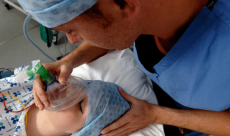
Last Friday I had my bottom wisdom teeth removed because they were impacted—which means that they were touching the sides of my jaw and getting stuck. I had to have a special procedure to remove only the top section of the teeth, to avoid damaging the nerve below them. Because the procedure was complicated, and it is easier to operate on someone asleep, I was put under general anaesthetic.
A general anaesthetic is a drug which brings about a reversible loss of consciousness, so the patient can be put to sleep and be unaware of pain for the duration of an operation. Before the invention of anaesthetics, operations would be extremely painful and traumatic events. People would rely on alcohol to numb themselves, and generally pass out anyway due to the severity of the pain. Since the 18th century scientists had experimented with gases like nitrous oxide, which is still used in surgeries today. From the early 19th century, ethers were a popular anaesthetic drug, but these aren’t used anymore as they are addictive and flammable.
Nowadays a doctor called an anaesthetist is responsible for calculating the dose of anaesthetic each patient requires, and then monitoring their progress throughout the operation. Some of these drugs are also used in lower dosages for pain management.
Anaesthetics can be given as either a gas, through a face mask, or intravenously, through a needle. Most of the time both methods are used at once, with the injection first to start the anaesthesia and the gas to continue it. Different liquids or gases are used for the inhalation method, most commonly desflurane, sevoflurane and isoflurane, though the latter is mostly used for veterinary surgery. These are usually delivered through an anaesthetic machine, which gives the patient a mix of the drug, oxygen and air, as well as monitoring their progress through the surgery.
Injectable anaesthetics are generally preferred, as they are faster, less painful and more reliable than the gaseous kind. The first intravenous anaesthetic was sodium thiopental, which was invented in 1934, and is still in use today. It causes unconsciousness in just 30-45 second! Other commonly used intravenous drugs are propofol, etomidate, and barbiturates such as methohexital. Propofol, referred to as the ‘milk of amnesia,’ is the most common and is on the World Health Organisation’s Model List of Essential Medicines.
The interesting thing about general anaesthetics is that scientists are still not one-hundred per cent sure how they work. One theory is that they activate inhibiting sensors in the nervous system, and inactivate the excitatory ones. Basically this means that it slows your whole system down. However, the exact effect that the drugs have on these different receptors is still under debate, not least because this effect doesn’t happen with every anaesthetic drug. With modern technology like MRI brain scans, scientists can now track how anaesthetics affect different regions of the brain. So far, so many different parts are affected that it’s been impossible to come to a solid conclusion. No matter how general anaesthetics work, what’s clear is that we are very lucky to have them, and the chance to have vital surgeries without experiencing pain.
Image: http://cdn.images.express.co.uk/img/dynamic/11/590x/anaesthetic-dementia.gif-404205.jpg

0 Comment:
Be the first one to comment on this article.